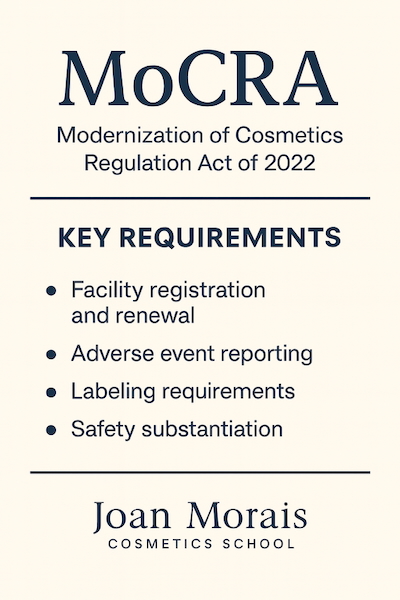MoCRA: The Modernization of Cosmetics Regulation Act of 2022
In December 2022, the U.S. Congress passed a landmark law for the cosmetics industry: the Modernization of Cosmetics Regulation Act of 2022 (MoCRA). This is the most sweeping update to cosmetic regulation since 1938, strengthening the FDA’s authority to ensure the safety of cosmetics sold in the United States.
The FDA (Food and Drug Administration) enforces laws enacted by Congress and will implement MoCRA by issuing new rules and guidance documents. This law impacts everyone in the cosmetic supply chain, from formulators and manufacturers to brand owners and marketers.
Learn about COSMOS Standards in this post.
Key MoCRA Requirements
-
Facility Registration
Cosmetic manufacturers and processors must register their facilities with the FDA and renew every two years. Selling or distributing cosmetics with a suspended registration is prohibited. (Small Business Exemption, if your business has less than $1 million in annual sales of cosmetic products in the U.S. (averaged over the past 3 years), you are generally exempt from the facility registration and product listing requirements. read about small business exemption below). -
Adverse Event Reporting
Companies must report any adverse events (health-related reactions) to the FDA within 15 days of receiving them from customers. -
FDA Access to Records
The FDA can inspect company records if there’s reason to believe a cosmetic is adulterated, during facility inspections, or in relation to adverse events. -
Ingredient Listing
Companies must submit cosmetic ingredient lists to the FDA and update them annually. -
Recalls
The FDA now has the authority to issue mandatory recalls if a company fails to voluntarily recall an adulterated or unsafe product. -
Voluntary Cosmetic Registration Program (VCRP) Discontinued
The old VCRP system has been retired. The FDA is developing a new registration and listing system, not yet available as of 2025.
Labeling Requirements
MoCRA strengthens FDA oversight of cosmetic labeling. Labels must now include:
-
Responsible Party’s Legal Business Name and Contact Information
-
Use your registered LLC name or sole proprietor’s legal/fictitious name.
-
Street address required (P.O. boxes not accepted unless the full business address is publicly available online).
-
Provide direct contact information for consumers to report adverse events: email, phone, or website.
-
-
Truth in Labeling and Advertising
-
The FTC enforces truth in advertising. Claims made on websites, social media, or marketing materials must match labeling regulations.
-
Be cautious with ingredient claims—if you say an ingredient is “antimicrobial,” it becomes a drug claim. Even linking to third-party sites with drug claims can be problematic.
-
Testimonials & Endorsements: If you control or influence reviews (influencers, free products, friends/family), you are responsible for compliance. Disclosures are required for gifted or compensated reviews.
-
-
Principal Display Panel (PDP)
-
The PDP is the front-facing portion of packaging.
-
Minimum font size depends on package size:
-
≤ 2 oz (60 ml): 1/16 inch
-
2 oz: 1/8 inch
-
-
Leave 1/8 inch clear space around text and ensure it is parallel to the base.
-
Safety Substantiation
Companies must now substantiate the safety of their products. Documentation should demonstrate product safety through:
-
Ingredient safety data (CIR, EU regulations, technical data sheets).
-
Certificates of Analysis (COAs) for botanicals and raw materials.
-
Certificates of IFRA conformity for fragrances and essential oils.
-
Microbial and stability testing to confirm shelf-life and safety.
Ingredient Declaration (Deck)
All cosmetics must list their ingredients on the label:
-
Order: List ingredients in descending order of concentration.
-
Ingredients >1% must be in descending order.
-
Ingredients <1% may be listed in any order.
-
Color additives always go last.
-
-
Blends: List components separately (e.g., BTMS-50 → Behentrimonium Methosulfate + Cetearyl Alcohol).
-
Fragrance: May be listed as “Fragrance,” though future rules will require allergen disclosure.
-
Botanicals: Use both common and INCI names (e.g., Aloe Vera (Aloe barbadensis)).
-
Soap: Option to list either raw ingredients or final saponified materials (e.g., Sodium Cocoate).
-
Net Weight: Must reflect the product weight without packaging.
GMP and Recordkeeping
MoCRA requires companies to follow Good Manufacturing Practices (GMP). This includes:
-
Ingredient Tracking System
-
Log receipts, assign lot numbers, review COAs, track supplier and batch details.
-
-
Batch Records
-
Maintain internal lot number traceability for every formulation.
-
Small Business Exemption
Companies with less than $1 million in annual sales (for three consecutive years) may be exempt from some requirements. However, this exemption does not apply to:
-
Injectable cosmetics
-
Cosmetics intended for ingestion
-
Long-lasting cosmetics (e.g., false eyelashes, artificial nails)
-
Products that contact the eye’s mucous membranes
Download Notes on MoCRA
Upcoming FDA Actions (2025 and Beyond)
-
PFAS in Cosmetics
By December 29, 2025, the FDA will publish a report on the safety of PFAS (per- and polyfluoroalkyl substances) in cosmetics. These chemicals are used to improve texture, shine, and water resistance but are highly persistent in the environment. -
Good Manufacturing Practices (GMP) Standards
The FDA will establish GMP standards aligned with international practices. -
Asbestos in Talc
FDA will develop standardized testing methods for detecting asbestos in talc-containing products.
Why MoCRA Matters
MoCRA represents a new era of accountability and transparency for the cosmetics industry. Cosmetic formulators, brand owners, and manufacturers must ensure:
-
Safe, well-documented formulations
-
Accurate labeling and compliant marketing
-
Proper facility and ingredient registration with the FDA
This law protects consumers while raising the professional standards of cosmetic formulation and production.
Stay informed: The FDA continues to issue new guidance and updates. Cosmetic businesses should regularly review FDA resources to remain compliant.
In the Professional Natural Skin and Hair Care Courses, we provide step-by-step guidance on understanding and implementing MoCRA requirements. You’ll learn exactly what actions to take and how to establish an organized compliance system. Once your system is in place, maintaining compliance becomes much simpler and more efficient.
You might also like


